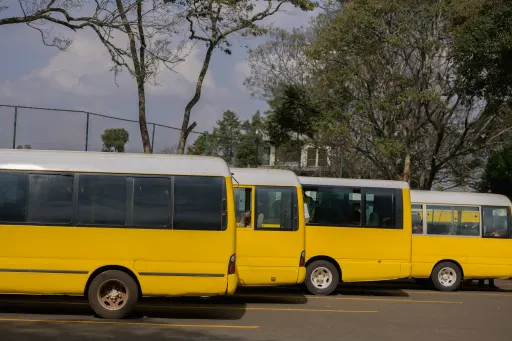In Kenya, school buses are a lifeline for millions of students, ferrying them to and from educational institutions across urban and rural landscapes. With the rising number of road accidents involving school transport, the National Transport and Safety Authority (NTSA) has implemented stringent Kenya school transport regulations 2025 to ensure the safety and well-being of students. These regulations outline critical compliance requirements, safety checks, and operational guidelines for school buses. This article provides a comprehensive guide to the rules a school bus must follow in Kenya, offering parents, school administrators, and transport providers the information they need to ensure safe school vehicle operations.
Why School Bus Safety Matters in Kenya
Kenya’s roads are among the busiest in East Africa, with school buses navigating bustling urban centers like Nairobi and Mombasa, as well as challenging rural terrains. According to the NTSA, over 315,000 public service vehicles, including school buses, were flagged in 2025 for operating without valid inspection certificates, highlighting significant safety concerns. The tragic loss of lives in school bus accidents, such as the fatal crash in Mityana District in August 2025, underscores the urgency of adhering to school transport safety protocols. By enforcing strict regulations, the NTSA aims to reduce road traffic crashes caused by mechanical failures and human error, ensuring that students travel safely.
This article delves into the specific rules outlined in the Draft Traffic (School Transport) Rules 2025, alongside additional NTSA guidelines, to provide a clear roadmap for compliance. From operational hours to driver conduct and vehicle maintenance, we cover everything you need to know to keep school buses safe and compliant in Kenya.
Key Regulations for School Bus Operations in Kenya
The Draft Traffic (School Transport) Rules 2025 set forth by the NTSA provide a detailed framework for school bus operations. These rules address everything from vehicle design to driver responsibilities, ensuring that every aspect of school transport prioritizes student safety. Below, we break down the key regulations, integrating insights from recent NTSA directives and compliance checks.
1. Operational Hours and Authorized Passengers
School buses in Kenya are subject to strict operational guidelines to minimize risks during transport. The NTSA mandates the following:
- Operating Hours: School vehicles must operate between 5:00 AM and 10:00 PM to avoid nighttime travel, which poses higher risks due to reduced visibility and fatigue. This ensures students are transported during safer daylight hours.
- Authorized Passengers: Only teachers, parents, guardians, chaperones, school staff, drivers in training, or substitute drivers are permitted to ride in a school bus while students are being transported. This rule prevents overcrowding and ensures that only trusted individuals are present, reducing potential safety hazards.
These restrictions are designed to maintain order and safety, ensuring that school buses remain a secure environment for students.
2. Safe Boarding and Exiting Procedures
Proper boarding and exiting procedures are critical to preventing accidents. The NTSA outlines the following rules to ensure safe student movement:
- Vehicle Positioning: School buses must be stopped and properly positioned before students can board or exit. Drivers are required to stop as far off the paved or main traveled portion of the road as the shoulder permits, particularly on the left side of the road, to avoid obstructing traffic.
- Designated Stops: Students must have a definite place to board and exit the bus. They are not allowed to exit at any location other than their regular stop without written permission from a parent, guardian, or relative caregiver, approved by the school principal or designated official.
- Prohibited Stopping Areas: Buses must not stop near the crest of hills, on curves, or on steep inclines to avoid collisions and ensure safe boarding conditions.
These measures ensure that students board and exit in controlled, safe environments, minimizing the risk of accidents.
3. Driver Responsibilities and Conduct
The driver plays a pivotal role in ensuring school bus safety. The NTSA emphasizes the following responsibilities:
- Maintaining Discipline: Drivers are tasked with maintaining order on the bus and must report any cases of disobedience or misconduct to designated school officials. This ensures a calm and safe environment for all passengers.
- Disciplinary Actions: No student may be discharged from the bus for disciplinary reasons except at their home or school, and the principal or designated official must be notified immediately. This prevents students from being left in unsafe locations.
- Driver’s Seat Restrictions: Only the driver may occupy the driver’s seat, and they must not leave it while the engine is running or leave the key in the ignition. This reduces the risk of unauthorized vehicle operation.
- Door Safety: Vehicle doors must remain closed and latched while the bus is in motion to prevent accidents.
These rules underscore the driver’s role as the first line of defense in ensuring student safety during transit.
4. Student Seating and Safety Measures
Proper seating arrangements and safety equipment are non-negotiable for school buses. The NTSA mandates:
- Allocated Seats: Each student must be assigned a specific seat to prevent overcrowding and ensure accountability.
- Child Restraints: No child under 12 years of age may sit in the front seat unless it is equipped with proper child restraints, ensuring younger students are adequately protected.
- Clear Aisles and Exits: Drivers or attendants must ensure that the bus’s aisle and exits are not blocked by luggage, maintaining clear pathways for emergency evacuations.
- Prohibited Materials: No undesirable materials, such as posters depicting cigarettes, alcohol, or pornography, may be displayed inside or outside the bus, creating a safe and appropriate environment for students.
These measures prioritize student comfort and safety, reducing risks associated with improper seating or cluttered pathways.
5. Vehicle Safety Features and Compliance
The NTSA places significant emphasis on the mechanical and structural integrity of school buses. Key requirements include:
- Speed Limiters: All school buses must be equipped with functional speed limiters compliant with KS 2295:2018 standards. These devices must transmit data to the NTSA’s Intelligent Road Safety Management System (IRSMS). Non-compliance, such as operating with expired or non-functional speed limiters, is a major safety violation.
- Seat Belts: All seats must have functional seat belts with secure buckles. Defective or missing seat belts are grounds for non-compliance.
- Vehicle Construction: School buses must adhere to KS 372:2019 standards, including proper seat anchorage, anti-roll bars for stability, and a visible VIN plate. Vehicles must be constructed by approved body builders and assessed by approved conformity assessors, as listed on the NTSA website.
- Exterior and Interior Condition: Buses must be free of corroded chassis, worn shock absorbers, or defective steering systems. Interior conditions, such as upholstery and door locks, must meet safety standards to prevent injuries.
These requirements ensure that school buses are mechanically sound and equipped to protect students in the event of an accident.
6. Mandatory Signage and Signals
To enhance visibility and alert other road users, school buses must adhere to specific signage and signaling requirements:
- Labeling: Vehicles must be clearly marked with the words “SCHOOL BUS” on the front and rear, and “DO NOT PASS WHEN RED LIGHTS ARE FLASHING” at the rear in block letters at least 8 inches high in black.
- Stop Signal Arm: Drivers must extend the stop signal arm and activate red-light indicators on the front and rear of the bus when stopping to receive or discharge students. Failure to do so is an offense, with penalties including a six-month driving license suspension.
These visual cues are critical for alerting other drivers and ensuring safe student boarding and exiting.
7. Routine Maintenance and Safety Checks
Regular maintenance and compliance checks are essential for keeping school buses roadworthy. The NTSA mandates:
- Routine Maintenance: School transport providers must conduct routine maintenance to identify and address mechanical issues, such as faulty suspension or steering systems, to prevent crashes due to mechanical failures.
- NTSA Safety Checks: The NTSA conducts random safety and compliance checks to ensure adherence to regulations. Schools and transport providers must cooperate fully with these inspections.
- Inspection Certificates: All school buses must have valid motor vehicle inspection certificates. The NTSA has flagged 315,000 vehicles, including school buses, for operating without these certificates, urging immediate remedial action.
- NTSA Mobile App: Law enforcement officers are encouraged to use the NTSA mobile app to verify the validity of inspection certificates, enhancing enforcement efforts.
These measures ensure that school buses remain in optimal condition, reducing the risk of accidents caused by mechanical failures.
Challenges in Enforcing School Bus Regulations
Despite the comprehensive framework provided by the Draft Traffic (School Transport) Rules 2025, enforcement remains a challenge in Kenya. Common issues include:
- Non-Compliance with Speed Limiters: Many school buses operate with non-functional or expired speed limiters, compromising safety.
- Poor Vehicle Maintenance: Substandard interior conditions, such as ripped seats and defective door locks, are prevalent, posing risks to students.
- Resistance to Regulations: Historically, Kenyans have resisted transport regulations, as seen with the “Michuki Rules” in the early 2000s, which faced opposition despite improving road safety.
- Overcrowding and Unauthorized Passengers: Some school buses carry unauthorized individuals or exceed capacity, increasing the risk of accidents.
Addressing these challenges requires collaboration between schools, transport providers, parents, and the NTSA to prioritize school transport safety.
The Role of Stakeholders in Ensuring Compliance
Ensuring compliance with Kenya school transport regulations 2025 is a shared responsibility. Key stakeholders include:
- School Administrators: Must verify that transport providers meet NTSA standards, including vehicle maintenance and driver training.
- Parents and Guardians: Should ensure their children board only roadworthy buses and report any safety concerns to school officials.
- Transport Providers: Responsible for maintaining vehicles, adhering to operational guidelines, and training drivers to follow NTSA rules.
- NTSA and Law Enforcement: Conduct regular inspections and enforce penalties for non-compliance, using tools like the NTSA mobile app.
- Students: Must follow driver instructions and use designated boarding points to maintain order and safety.
By working together, these stakeholders can create a safer environment for school children across Kenya.
Recent Developments in School Bus Safety
In 2025, the Kenyan government and NTSA have taken significant steps to enhance school vehicle operation guidelines:
- Draft Traffic Rules: The gazetting of the Draft Traffic (School Transport) Rules 2025 by Transport Cabinet Secretary Davis Chirchir mandates inspections for all vehicles older than four years, including school buses.
- Public Awareness Campaigns: The NTSA has urged the public not to board or allow children to travel in unroadworthy vehicles, emphasizing shared responsibility for road safety.
- Technological Integration: The use of trackers and the NTSA’s IRSMS to monitor speed limiters reflects Kenya’s push toward technology-driven safety solutions.
These initiatives demonstrate a commitment to reducing road fatalities and improving school transport safety in Kenya.
The rules a school bus is supposed to follow in Kenya are designed to protect the country’s most precious cargo—its students. From strict operational hours to mandatory safety features and driver responsibilities, the Draft Traffic (School Transport) Rules 2025 provide a robust framework for ensuring safe school transport. However, compliance requires vigilance from all stakeholders, including schools, parents, transport providers, and the NTSA. By adhering to these regulations, maintaining vehicles, and fostering a culture of safety, Kenya can significantly reduce the risks associated with school bus travel.
For more information on Kenya school transport regulations 2025, visit the NTSA website at www.ntsa.go.ke or download the NTSA mobile app to verify vehicle compliance. Together, we can ensure that every child arrives at school and returns home safely.





